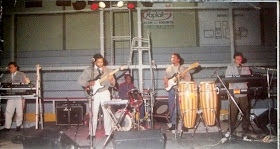More musical styles as we travel on to Guinea-Bissau. The Balanta, which means ‘those who
resist’, are the main ethnic group found in Guinea-Bissau. They make up more
than one-quarter of the population. The Fulani, whom we encountered in the Gambia, are the other prominent ethnic group of Guinea-Bissau.
The Balanta play a gourd lute instrument called a kusunde. The
Balanta kusunde is an ancenstor of the modern banjo. In the 1980s, musical genres
like kussundé (based on the music & dancing traditionally associated the
kusunde) began to become popular across the country, led by Kaba Mané, whose Chefo Mae Mae added an electric
guitar & used Balanta lyrics.
Kaba Mane began as a kora player. He then applied his musical
skills to the guitar. This music features interesting percussion. The
dynamic rhythm & style are Mane's own creation. It starts off as traditional
kussundé rhythm then turns into a soukous-styled sound.
On Chefo Mae Mae, the band are: Kaba Mane – vocals & rhythm guitar; Joanito – lead guitar; Salvador Emballo – second guitar; Paul Centeio – rhythm guitar; Braima Touré – bass; Charly Bokher & Yerahim Hosso – saxophones; Fredo – trumpet; Jean Marie Bolangassa – percussion; & Boffi Banengola – drums; with Tuti Carvalo, Aguibo Barry, Marie Evelyne Gillet, Tchando, & Ansumane Mane – backing vocals.
Kaba Mane - Chefo Mae Mae, Disques Espérance ESP 7519, 1986.
decryption code in comments
Face A –
Chefo Mae Mae
Lante N’Dam
Face B –
N’djimbala Yelaba
Badjibi
This one turned out to be, as Winston Churchill said: “…a
riddle wrapped in a mystery inside an enigma”. When looking for some further
information about this band, I kept getting contradictory information. At first
I chocked it up to ‘translation error’, but kept getting more errors.
Contradictory dates, varying release titles, different band members…that can’t
all be lost in translation. What does it all mean? After searching at least a
brazillion references (it seemed that way), I figured it out (to some
extent). Two bands…same name, same part of the world, overlapping members, & their various information had become well
blended, shaken not stirred. I believe I have (somewhat) unraveled the
riddle/mystery/enigma. Here goes.
Tabanka
Djaz version 1.0 –
The music of Guinea-Bissau
is usually associated with the polyrhythmic gumbé genre, the country's primary musical
export.
Rui
Cesar Neves Medina De Pina, born in Cape Verde in 1962, played the
drums in coladeira groups & began singing. Along with guitarist Tony
Cabral, pianist Danny Carvalho, bassist Antonio Gomes, guitarist Emiliano
"Lolo" Lima,
& percussionists Nhelas &
Hernane Medina, Rui helped formed the group Tabanka Djaz in 1981. Lima was replaced almost
immediately by guitarist Antonio “DaGaita” Teixeira. After a US tour in
1986, Tabanka Djaz broke up. They never reunited.
Tabanka Djaz version 2.0 –
In 1989, the two brothers of guitarist Tony Cabral, Juvenal
& Mikas Cabral started their version of Tabanka Jazz. They are one of the
most influential bands from Guinea-Bissau. They wanted to keep alive the musical
tradition begun by earlier bands like: Cobiana Djaz (whose song “Si Bú Esta
Dianty Na Luta” they covered on their first album); the original Tabanka Djaz;
Mama-Djombo; N'kassa Cobra; Free Africa; Capa Negra; Tchifri Pretu; &
others. Due to economic & political factors, most of these bands were no
longer performing.
Undeniably, their musical contribution marked a new stage in
the process of innovation, dissemination & promotion of gumbé. Tabanka Djaz
perfected their style playing the bars & clubs of Bissau. Tabanka Djaz play an original style
of gumbé tinged with the sounds of kussundé, Portuguese fado, Brazilian samba, Cape Verdean
morna & coladeira, even Angolan kizomba.
Tabanka Djaz 2.0 was originally comprised of Micas & Juvenal
Cabral, José Zé Carlos Aguinaldo Silva & Rui Pina. A short time later, José
Carlos left the group & was replaced by Calo & Janio Barboza. In 1990 the
band released their first album Tabanka. Three years later, the band's second
album, Indimigo, was released. At this time Rui Pina left the band to form his own
band, Ice. Sperança is the third album by the new Tabanka Djaz. It was their
most widely accepted work to date.
On Sperança, Tabanka Djaz are: Micas Cabral – vocals, lead
& rhythm guitar & programming drums; Calo Barbosa – vocals & keyboards;
Juvenal Cabral – vocals & bass; & Janio Barbosa – keyboards &
backing vocals.
Tabanka Djaz – Sperança, Lusafrica, 1996.
decryption code in comments
Tracklist –
Sperança
Lisa Cherry
Nha Coraçon
Sub 17
Brincadera D' Aós
Rusga di 7.30h
Nha Amiga
Tira Mão da Minha Xuxa
Lisa Cherry
Nha Coraçon
Sub 17
Brincadera D' Aós
Rusga di 7.30h
Nha Amiga
Tira Mão da Minha Xuxa
NØ






Kaba Mane
ReplyDeleteKWhFHTsQlpxWOwBdHKiZOirLY2kwNtzoAwtPRl2rmeY
Tabanka Djaz
L2ndYnbixWHu0WrUs0SWmFYARpRX8LSm6uVGibzrAQg